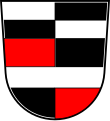Rorer (noble family)
Rorer was the name of an old Frankish noble family .
history
The Rorer family was first mentioned in a document in 1272 with Conradus (I.) de Ror appearing as a witness during a transfer of goods to the Waldsassen monastery . The headquarters in the village of Rohr ( Nový Drahov ), north of Eger ( Cheb ), was in the colonization area of the Notthracht family at Wildstein Castle ( Skalná ). Similar to the Schirndinger or the von Brand family , the Rohrers were originally part of the Notthracht family's ministry. After the fall of the Hohenstaufen the Egerland ministerials were forced to reorient themselves. While Conrad I and his descendants subsequently found themselves in various places in the Egerland as country nobility, the descendants of Conrad's brother Martin sought admission to the Eger city patriciate. Until the neo-Gothic reconstruction of the Eger town church St. Niklas , the family's hereditary burial was located there with their coat of arms carved in stone (now lost).
In 1317 Heinrich Rorer was killed by farmers from the Waldsassen monastery . The family had previously made claims in Altalbenreuth ( Mýtina ), which were claimed from the monastery with the acquisition of Hardeck Castle . On April 22, 1317 there was a settlement.
Property in Franconia
Peter Rorer has been based in Bernstein near Wunsiedel since 1360 . In 1398 he was first recorded in possession of goods in Höchstädt . His brother Erhard , who appeared as a district judge in Weiden in 1404 , was also wealthy there. Gradually the Rorer expanded their property around Höchstädt; In 1467 there is talk of their newly built castle in Höchstädt. The Oberhöchstädt manor was created, to which not only numerous properties in Höchstädt itself, but also goods in Braunersgrün and Hebanz as well as the entire village of Hauenreuth belonged. In 1559 the brothers Gottfried and Reichardt Rorer sold their Höchstädt property to Hans Gangolf von Witzleben and retired to the Stockau ( Štokov ) estate near Tachau ( Tachov ) in Bohemia.
coat of arms
Silver bar on a shield quartered in red and black.
Municipality coat of arms of Höchstädt in the Fichtelgebirge above in memory of the Hohenzollern , below of the von Rorer family
Bernstein coat of arms, now part of Wunsiedel
See also
- List of German noble families
- List of Bavarian noble families
- List of Frankish knight families , knight canton Gebürg
literature
- František Kubů: The Staufer Ministry in the Egerland . Pressath 1995.
- Harald Stark : The Oberhöchstädt manor . In: Archive for the history of Upper Franconia . Vol. 78, Bayreuth 1998. pp. 41-112.
- Heribert Sturm : Districtus Egranus . Munich 1981.
- Cord Ulrichs: From feudal court to imperial knighthood - structures of the Franconian lower nobility at the transition from the late Middle Ages to the early modern period . Franz Steiner Verlag Stuttgart, Stuttgart 1997, ISBN 3-515-07109-1 . P. 212 (List of the canton of Gebürg from 1529, StAM GHA II. No. 211 aE).
- Prockl Vincenz: Eger and the Egerland . Prague / Eger 1845.
Web links
Individual evidence
- ^ Rudolf Langhammer : Waldsassen - monastery and town . Waldsassen 1936, p. 149.


